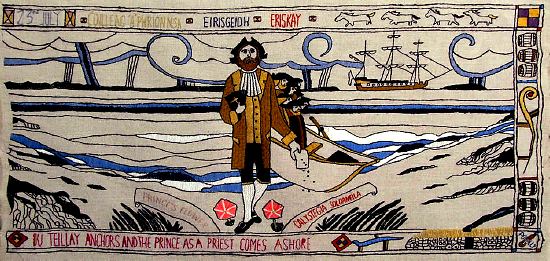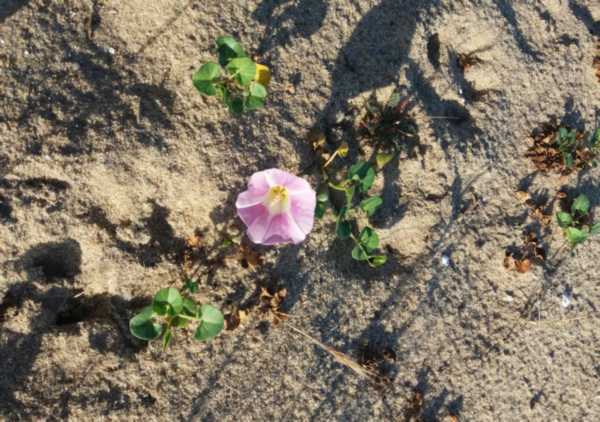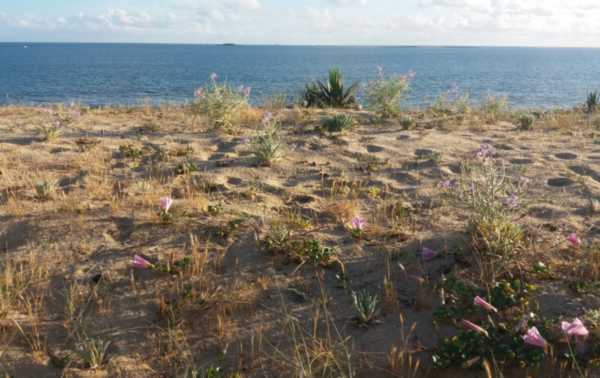The Prince's Rose on Eriskay - Breton proof botanical of its origins!
Whisky Galore and the Prince's Rose - great stories and seemingly both true!
Compton MacKenzie made famous the wreck of The President off Eriskay in his famous novel Whisky Galore. But long before that, in fact two centuries earlier another tale took hold. When Bonnie Prince Charlie landed to begin his campaign to regain the throne of his father in 1745 legend has it he dropped seeds on the shore from his pocket that he had earlier gathered in St Nazaire. They grew to become The Prince's Rose, as depicted [centre] in 2010 on the tapestry panel of the Eriskay Landing embroidered by Sue MacDonald and Neilina MacInnes with the indispensable support of Helen MacLean, Christine Mitchell and Lena MacLellan. [The whisky barrels are in the right hand border!]

Breton Botanist Roland Mogn has recently examined the likelihood such seed planting could have taken place and been successful. His report, passed to the Battle Trust after the recent Exposition of the tapestry in Pornichet/ St Nazaire, is given below:
Roland Mogn’s paper on Calystegia Soldanella / The Prince's Rose [translated by Jean Cévaër]
The Calystegia Soldanella is found only at the top of open seashore dunes, that is where sand continues to build up and move. It grows on a bandwidth of a few metres to a few tens of metres. It needs a saline environment. [The picture immediately below was captured at Sainte Marguerite in Brittany in June 2017 by Breton colleague Hubert and the next below at Pornichet - this story originally reported here in June 2012.]


It can develop at many latitudes, which means that it can put up with large changes in temperature, but Eriskay seems really to be the Northern-most place in Western Europe where it can develop.
Calystegia Soldanella bears summer flowers that are large, some 8 centimeters in diameter. They are white with pink stripes. [The tapestry panel has them reversed!]
The seeds are spherical, rather large and heavy, and they can bear foot pressure with no problem.
Calygestia Soldanella is frequently found in the Saint-Nazaire area, where it grows mostly underground. The only parts coming out of the sand are some kidney like leaves and the quite impresive flowers.
Botanical knowledge can explain why Calystegia Soldanella is to be found in Eriskay to-day. But the question is how did it get there? Because Eriskay is a territory situated far away from the common territories where the plant is living it must have been brought there.
It could have been brought there by migratory birds, yet the weight and the round shape of the seeds, their perfect surface without hook or plume like shapes, makes it u unlikely that a bird could carry these seeds with its feet or in its feather. Therefore it would seem that the seeds were carried otherwise to Eriskay, and why not by Bonnie Prince Charlie himself as history has it?
This seems to be the only case out of several hundred when a plant has been introduced in a new territory only as seeds. And since very few models, perhaps none, of this type of introduction are known, it is well possible that the legend of the Prince bringing the seeds to Eriskay in 1745 from Saint-Nazaire is true.
Of course it was a stroke of luck that Calystegia Soldanella, because it is impervious to large changes in temperature, could migrate from the dunes of Saint-Nazaire to the dunes of Eriskay.
So this is surely a case when the botanical truth meets and comforts the historical legend.
____________________________________________________________________
Le Calystegia soldanella ne se trouve que sur le haut des dunes maritimes ouvertes (là où le sable continue d'être mobilisé), sur une frange de quelques mètres à quelques dizaines de mètres de large. Il lui faut un peu d'apport de sel. Il est cosmopolite, c'est-à-dire qu'il supporte une grande amplitude thermique, mais la station de Eriksay est bien sa limite Nord-Ouest européenne.
La plante fleurit l'été. La fleur est grande (8 cm. de diamètre), blanche striée de rose. Les graines sont sphériques grosses et lourdes. Elles résistent au piétinement. La plante est commune dans la région de Saint-Nazaire. L'appareil végétatif est principalement souterrain. Ne dépassent du sable que quelques feuilles réniformes et des fleurs spectaculaires.
Les données de la botanique peuvent donc très bien expliquer la présence du Calystegia à Eriskay. Reste à savoir comment la plante a pu parvenir là-bas. La station d'Eriskay est un isolat séparé de la zone de répartition principale de la plante. Il y eut donc eu un apport. On peut envisager que cela ait pu être fait par un oiseau migrateur. Cependant, la taille des graines, leur poids, leur surface lisse comme une bille, sans système d'accrochage (plumets etc.) sous des pattes ou dans des plumes plaident pour un transport non aviaire, ce qui renforcerait la véracité du récit de l'intervention de Bonnie Prince Charlie.
C'est le seul cas (sur des centaines) où une plante est introduite sur un territoire nouveau sous forme de graines. L'absence de modèle antérieur plaide en faveur d'une démarche originale dont la réalisation est, de par sa simplicité, tout à fait possible historiquement. Il y eut aussi un coup de chance : cette plante, qui supporte de grandes amplitudes thermiques, est l'une des rares espèces que l'on pouvait transporter, avec quelque chances de germination, des dunes de Saint Nazaire à celles de l'île d'Eriskay.
Roland Mogn
Published Date: June 5th 2017
|





